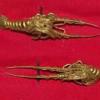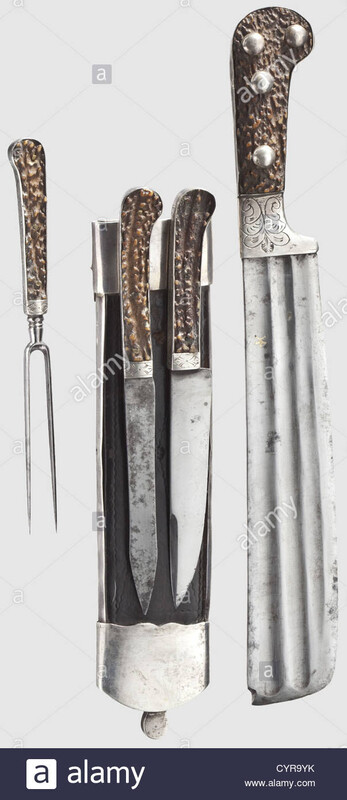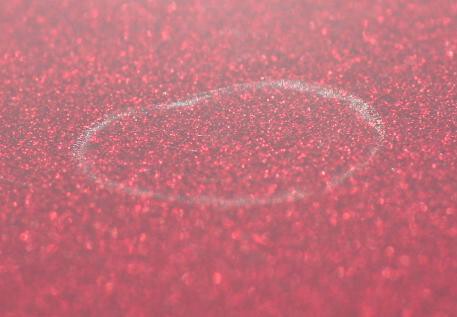-
Posts
435 -
Joined
-
Last visited
Content Type
Profiles
Forums
Events
Store
Downloads
Gallery
Everything posted by Lance
-
Looks very similar to the little fork found as one of the side tools in European Hunting swords/hangers or more specifically a trousse knife? I think these were most popular in Europe 1500-late 1700s usually attributed as made in Germany. Sometimes the tools were carried in little pockets in the scabbards of long frighting swords too; The proportions are a little off compared to European versions, yours seems like it was made to fit in a saya pocket like an umabari but I think it's reasonable to think influence at least. Attached an image below, more examples can be seen with google images using search terms trousse knife or hunting hanger sword. It may seem like a reach but if you look carefully the silhouette they matches the decorative profile of where the handle and blade/fork often meet on the trousse accessories. Yours is definitely of Japanese make, maybe once part of a set made for a European traveler or or ordered by a Japanese person due to one of the many bouts of fascination with Europeans and their dress? Regards, Lance
-
An alternate term that others might be thinking of is Tama (jewel) I mostly see that term used for Shinto blades, Osaka schools in particular. The hamon is said to be more contrived or "painted on" Not a fake hamon using hadori or other artificial techniques, just less organic. Sukehiro on Tamba Yoshimichi smiths come to mind, with tama apearing somewhere in toranba and sudare sometimes. I'm not sure if the term really fits for your sword though as those seem to be 100 percent intentional a circle ridindg a wave whereas your hamon looks more like an unintentional natural occuring part of the heat treatment. Hope this is of some use, Lance I think yo
-
I'd go for a Hardcover edition too, Regards, Lance
-

Need Help With Identification Of Sword
Lance replied to pats22shirley's topic in Military Swords of Japan
Tthe 2 most common reasons usually given for these types of swords in "civillian" mounts were resurgent interest in martial arts in Japan and rising interest for their past history (nationalism) leading to greater demand for swords by the public. Regards, Lance -

Harp Stamp On Yasukunito Tsuba
Lance replied to Surfson's topic in General Nihonto Related Discussion
Hello Robert, I don't think they worked exclusively for Yasukuni Shrine, (I've had quite a few with one remaining in my collection, none were Yasukuni Swords) Or did your friend mean that Yasukuni Shrine only used Suya company?. They do (on average ) seem to have produced the best quality gunto mounts.when it came to finishing work and materials though. Regards, Lance -
Aside from kizu could be a bit of moisture left on the blade when put into saya at some time and it left a water mark/stain. Hopefully that's all it is but you'd need to inspect it to be sure. Regards, Lance
-
Below is a tsuba with Kao at the bottom that looks similar(if only in shape) to one of the markings in your pics http://www.mfa.org/collections/object/tsuba-with-design-of-shoki-on-horseback-with-an-oni-attendant-11604 I'm not sure why this would be found on your seppa as they're usually specific to a certain artist; the quality of the fittings on your sword aren't at the same level, so some kind of odd attribution to this Hironaga is unlikely. Most likely simply some kind of assembly marks that happent to look similar. Regards, Lance
-

Cloisonne Fittings Enlightenment
Lance replied to tokashikibob's topic in General Nihonto Related Discussion
Most cloissonne mounts like in the auction seem to be Meiji period. Some may have been made for export but I'd bet some of the higher quality work was ordered at the time by Japanese as well.. While not intended "for battle" or daily wear, and maybe a little flashy for some, I think the workmanship on good examples can be very enjoyable for what they are. A well made example also, might have a decent blade, lesser quality of this type might have a blade similar to ivory/bone mounts, basically a metal tsunagi. Couple nice examples below, https://www.bonhams.com/auctions/18256/lot/2276/ http://www.christies.com/lotfinder/arms-armor/a-fine-cloisonne-tachi-signed-owari-kuni-5761088-details.aspx Regards, Lance -
Congratulations Ed, Wide horimono inset into large bohi does seem to be a Umetada trait of sorts (a couple examples in Nihonto Koza Shinto volume as well as the one I linked to) Some of the wear on the high points threw me off but I'm glad for you the Shinsa agreed with the attribution on nakago Sword in the link below looks like your tanto? https://www.bonhams.com/auctions/17513/lot/3158/ Regards, Lance
-
Link below to compare horimono quality, http://www.emuseum.jp/detail/101110/001/004?word=&d_lang=en&s_lang=en&class=6&title=&c_e=®ion=&era=&cptype=&owner=&pos=81&num=8&mode=detail¢ury= Regards, Lance
-
Looks great! Very happy for you to see how well they go together. Best Regards, Lance
-
If I had the right fittings something like Tensho or Higo two pockets. More typical Edo style no pockets , Regards, Lance
-
Maybe the wartime switch to an extra ana and type 3 mounts was to make up for the lower quality materials (cotton ito and thinner ray skin) less skilled mass production (Seki) compared to traditional craftsmen who were able to fit the tsuka properly? Lacquered ito would probably hold up better to abuse and not deteriorate out in the field as much (jungle rot?) Regards, Lance
-
I'll throw in a quick two cents and agree about the workmanship angle;: my understanding of descriptive terms like hard and soft iron tsuba has more to do with the way the artists worked the plate and it's finished appearance. In addition to the sheen mentioned above by Henry, the impression of soft iron would be the iron worked in a way that seems more organic, almost as if it was it was formed by hand like pottery rather than a hammer.. Maybe tsuba like Higo Jingo, Kaneiye or the many good sukashi tsuba makers with bones? Something seen as being constructed from a hard plate would be more uniform and smooth In these the texture of the plate itself isn't part of the overall design and acts as more of a canvas for for the design itself like Choshu, Soten,; and some Mito school stuff? Maybe some others too where the plate looks more "dry" (Not that it was asked but I don't think either could be considered superior, as there are great examples of both types and after that it would come to personal tastes) Regards, Lance
-
http://www.to-ken.com/full.php?article=p00050&type=article Regards, Lance
-
Hi Kam, I guess there must have been more contact with the Asian market for reproductions in Australiia in the 70's and 80's than there was here, as something like this wouldn't be encountered back then. There were a a few types of copies that turned up and sold as late war but they immediately recognized, Maybe more skepticism is required today due to the increase in international trade. I still think the blade has a chance of being legit, but something like this likely requires in hand viewing, I might be taking these images and mis-interpreting or projecting my own experiences with the Amahide and other swords I've owned and handled and coming to wrong conclusions. Regards, Lance Or....(see pic below )
-
New pics of tang look less suspect than before, I'm going to climb back out on my limb and say mumei Gendaito. Very similar to Amahide I had, and the Kanenaga posted earlier, possibly made in one of the many wartime Seki sword factories?. Mounts look to be ok, thin seppa aren't that uncommon, especially on gunto in leather covered saya "field mounts" Regards, Lance
-
From the new tang picture, looks like I was wrong too, hopefully a refund is possible. Regards, Lance
-
Hi Kam, Hopefully the tsuka can be removed and the mystery solved one way or the other, maybe some better pics of overall shape of the mounts and the blade under different lighting too.... . I understand the skepticism about the tsuka but for whatever it's worth I've come across so many different grades of gunto tsuka, both in material quality and assembler's skill levels (pre-internet and ebay) at flea markets, small gun shows. or garage sales direct from the famiilies, I'm not trying to tout myself as an "expert" just that I'Ive seen a lot of swords that you could be 99.999% sure were never tinkered with and this fits in with those pretty well. (Now I'll end up being wrong , although for Bob's sake I hope I'm not ) Best regards, Lance
-
I think as Ian suggested, I wouldn't be surprised to see an Amahide mei if you're able to remove the tsuka. No pictures, but I used to have a sword by him (maybe 10-15 years ago?) with identical hada, the hamon was also somewhat overpowered by the forging pattern too. I used to keep a little sketchbook of oshigata and tang rubbings of swords that I picked up, and I remember spending a good amount of time sketching the hada and hamon on the Amahide to capture it as it was very unusual to me at the time. (wish I still had it as it would have been useful here) The tsuka looks OK to me, even the raised area along the same'. I've seen this a lot on WW 2 Seki mounts, instead of more expensive/traditional method of making a handle: , they'd carve a shallow panel and inlay a thin piece of ray skin, skipping the paper strips along the top and bottom edges, as well as the triangular pieces of paper that go under the ito. If you do manage to get the handle off please post what you find. Regards, Lance
-
Aside from tamaghane, some smiths also make their own steel, (oroshigane?) using materials from old buildings/ shrines etc. My understanding is ieven though not striclly tamaghane, the smiths are pretty much creating their own. In the case of meteoric iron it would be combined with or turned into this traditional material and is perfectly acceptablle. The topic below has a good discussion of processing old steel, hope this is of some use: http://www.militaria.co.za/nmb/topic/8695-recycled-steel/ Regards, Lance
-

Earliest Date On A Kogarasu Maru Blade?
Lance replied to jct3602's topic in Military Swords of Japan
My mistake,, I believe these started beingt made in the late 1870's-1880's when Japan was westernizing their military, so the first use of this type of sword wouldn't pre-date your sword by much, maybe 10-15 years.. Regards, Lance. -

Earliest Date On A Kogarasu Maru Blade?
Lance replied to jct3602's topic in Military Swords of Japan
The famous Kogarasu Maru is supposed to date back to Nara-Heian period, (700-1100 AD) From what I've read over the years, any attempt at a more precise date was usually mid 900 ADl. I'd assume it wasn't the first sword ever made in this shape,( I think there are others around the same age) Maybe a rough estimate either 50 years before or after 900 would be reasonable? Regards, Lance. -
My understanding is that (in general) Muromachi and earlier tsuba were smaller or thinner. Most times I've seen this in print or discussed it would usually be attributed to katate-uchigatana being shorter and lighter; battlefield slashing cuts were a different fighting style, and the curvature and balance//fulcrum on Koto swords were more natural so the tsuba would serve more as a hand stop, guard and the owner's tastes. Shinto, especially Kanbun shape being more straight(ish) had a different balance so a larger heavier tsuba, even if only a few ounces could change the pivot point, plus Edo period tastes being more decorative, a larger tsuba allows for more ornamentation. I can think of a few exceptions though, it seems Yagu school tsuba were on the small side as well as the guards mounted on Satsuma koshirae. Interesting topic, hope others post to expand and correct anything I've written. Regards, Lance
-

while waitin for shinsa a wakizashi would like your feedback
Lance replied to mr botanical's topic in Nihonto
I agree with Sebastien, Shinto Bizen-Osafune. Looking at the hamon maybe one of the many Shinto Sukesada smiths. I attached an old (poor quality) picture of a Shinto wakizashi signed Sukesada I have to compare, Also a picture of Mount Fuji, if you look at the individual peaks on the hamon of your sword it has a strong resemblance, I think it originally started out as a gunome midare with the top called "crab claw" and evolved/became a more rigid pattern; you can often see variations of this on Shinto Sukesada or related smiths. . Hope this is of some use, Lance








